On the morning of June 30, provinces and cities across the country will simultaneously organize the "Ceremony to announce the National Assembly 's Resolution on merging provinces and cities, along with the Party Central Committee's decisions on establishing provincial Party committees and local leadership personnel".
From 8:00 a.m., the whole country simultaneously held the Ceremony to announce the resolutions and decisions of the Central and local governments on merging provincial and communal administrative units, establishing party organizations, appointing Party committees, People's Councils, People's Committees, and Fatherland Fronts of provinces, cities, communes, wards, and special zones.
This is a major political event, of historical significance to the country, when the country was rearranged not only to be more compact but also to develop more strongly.
General Secretary To Lam will attend the announcement ceremony at the Ho Chi Minh City bridge point, President Luong Cuong will attend the announcement ceremony at the Hanoi bridge point, Prime Minister Pham Minh Chinh will attend the ceremony at the Hai Phong city bridge point, National Assembly Chairman Tran Thanh Man will attend the announcement ceremony at the Can Tho city bridge point; Standing member of the Secretariat Tran Cam Tu will attend the ceremony at the Da Nang city bridge point.
Many Party and State leaders also came to localities to attend the announcement ceremony.
Speaking to the people of Ho Chi Minh City, General Secretary To Lam emphasized: the unification of the three localities is not a simple accumulation, but the crystallization of common intelligence and will to develop, to form a megacity - a financial, production, logistics, and innovation center of regional and world stature.
This new development space is built on a long-term vision, aiming at synchronous, sustainable and scientific development. This is the most vivid expression of strategic thinking, innovation in the model of government organization, to serve the people better, closer to the people and more effectively. This is a pioneering and breakthrough step in reforming the organization of the urban government apparatus, creating favorable conditions for the rapid, strong and effective development of the most urbanized region in the country.
This model will help increase autonomy and flexibility in management, while creating a clear institutional framework for satellite cities, industrial parks - logistics - seaport services to fully exploit their potential. Most importantly, the state and the serving government will no longer be a slogan but will become a concrete, substantive action, reaching the people and businesses.
On behalf of the Party and State leaders, General Secretary To Lam respectfully called on all cadres, party members, civil servants, public employees, workers, soldiers of the armed forces, the business community and people of Ho Chi Minh City to unite, act resolutely, creatively and with discipline, to bring this unified city to new heights.
General Secretary To Lam stated that this is a challenge, but also a historic opportunity. The success of the New City cannot come from documents or resolutions alone, but must come from consensus among the people, determination in leadership and dedication in implementation.
The General Secretary hopes that the City's leaders will maintain their mettle, promote collective intelligence, be close to the people - respect the people - act for the people, put the interests of the Fatherland and the people above all; together arouse the will to rise up, turn every street, street, alley, residential area, factory, field, river, and coastline into a symbol of prosperity and integration. Ho Chi Minh City with its achievements after exactly 50 years of liberation is not only a bright spot of Vietnam, but will also be a meeting point of Asia and the world. Let's join hands to act to be worthy of the trust and hope of the Party, State and people.
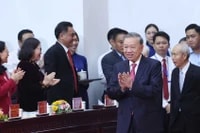
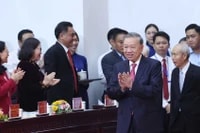
[Photo] General Secretary attends the announcement ceremony of Resolutions on merging administrative units in Ho Chi Minh City
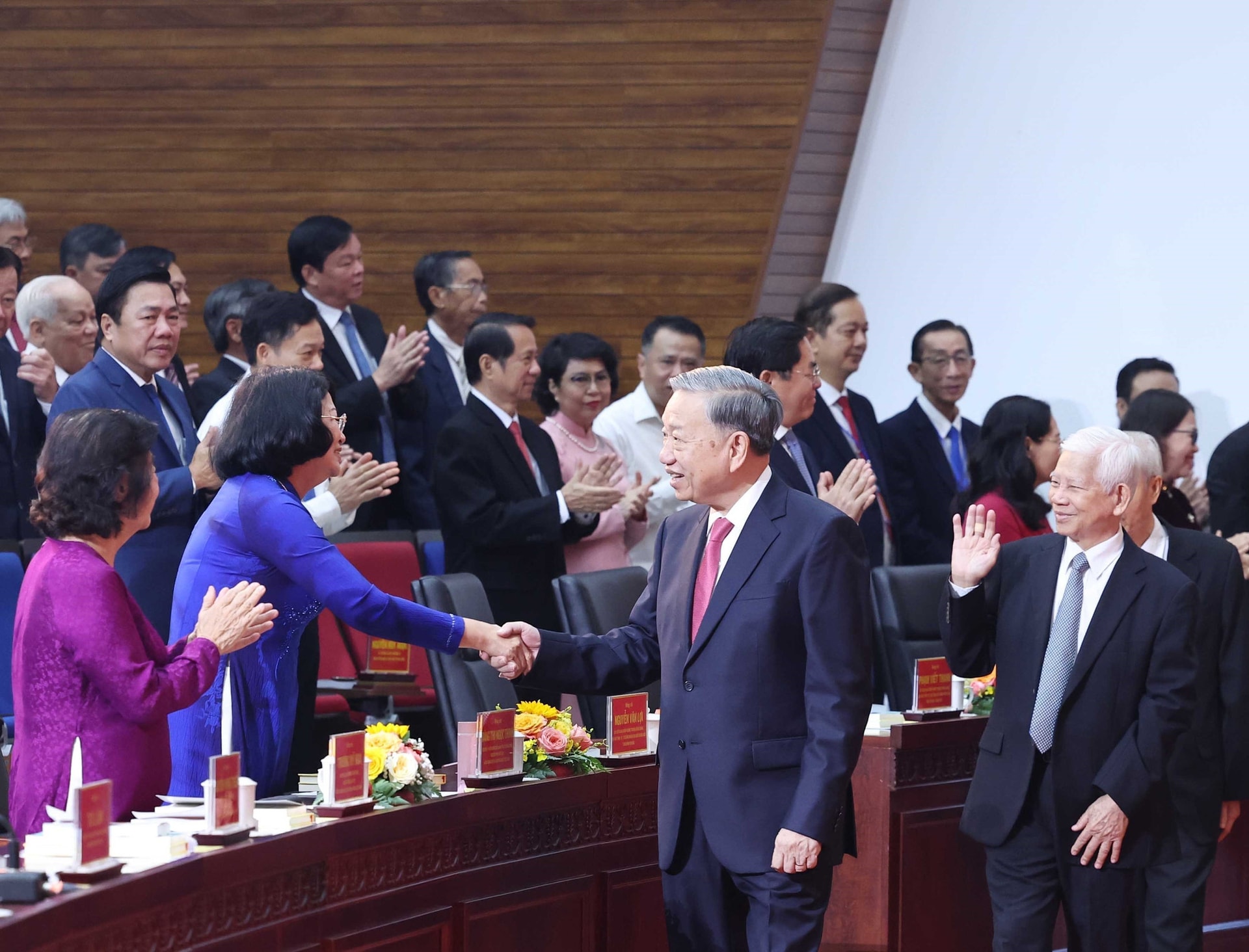
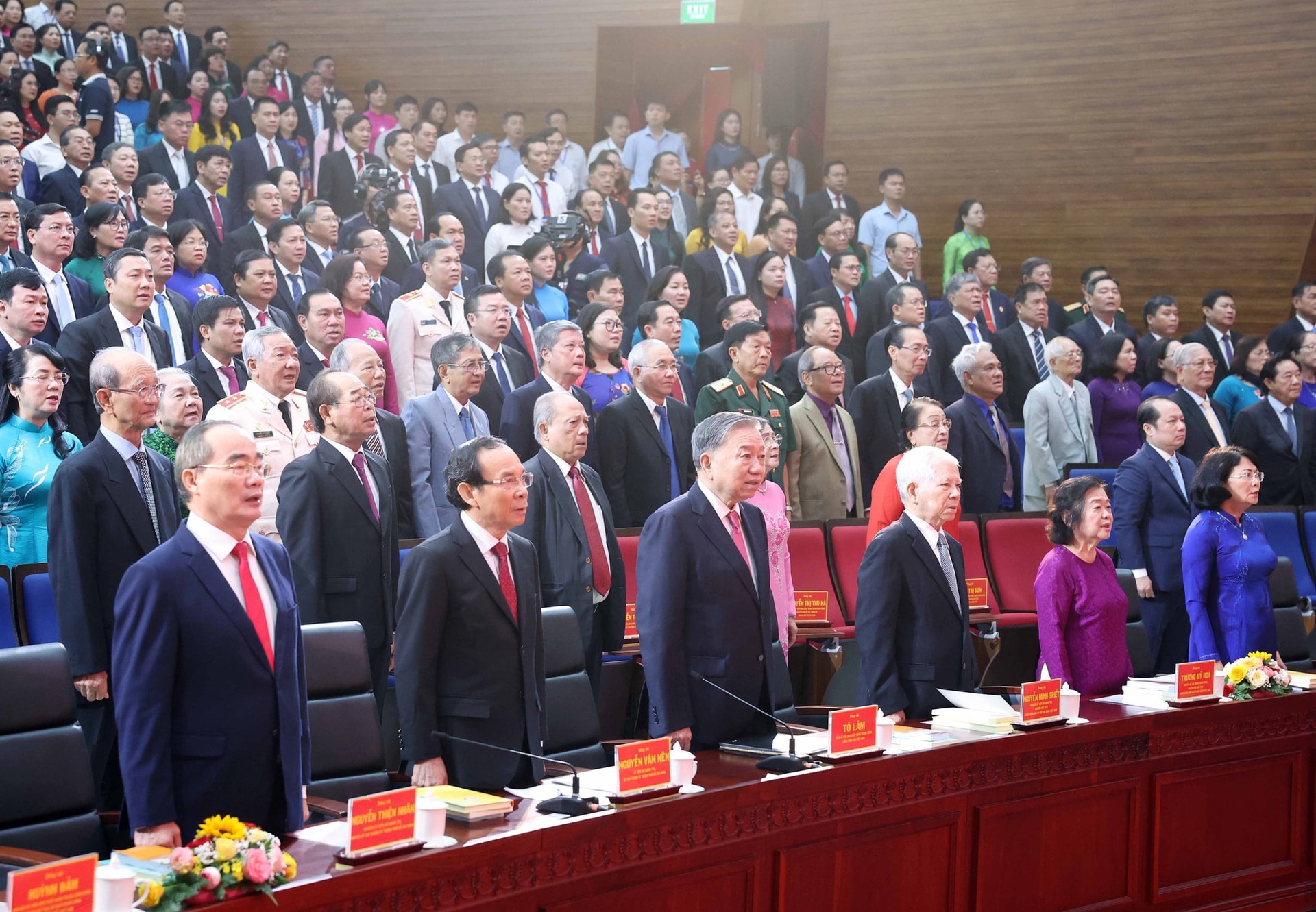
Speaking at the ceremony announcing the Resolution at the Hanoi bridge, President Luong Cuong stated that, implementing the Conclusion of the Secretariat, 34 provinces and cities across the country will simultaneously hold the Ceremony to announce the Resolutions and Decisions of the Central and local governments on merging administrative units, establishing party organizations, appointing Party committees, People's Councils, People's Committees, Fatherland Fronts of provinces, cities, communes, wards, and special zones. This is a very special milestone for the whole country and the capital Hanoi, starting from July 1, 2025, the local government apparatus of the whole country will officially enter a new phase - shifting from the three-level local government that has been operating for 80 years since the founding of the country to a two-level local government.
The President affirmed that this is a major and especially important policy of our Party and State, of long-term strategic nature, demonstrating great political determination in building a streamlined, efficient, effective, effective, and efficient administration that is close to the people and serves the people better. This is not just a simple adjustment of administrative boundaries, but also a step of great significance in terms of politics, organization, and ensuring the sustainable development of the country.
Especially for the capital Hanoi - a thousand years of culture and heroism, with a particularly important position and role, being the national political and administrative nerve center, the heart of the whole country, a major center of economy, culture, education, training, science - technology and international integration with the quintessential values of the nation, this administrative unit arrangement has a very great significance, aiming to meet the needs of urban, cultural and historical development; administrative reform, management, and more effective promotion of the space and resources of the capital.
The President assessed that in the recent past, the Hanoi Party Committee has been serious, responsible and creative in implementing the arrangement of agencies of the apparatus; proactively had a plan to terminate the operation of the district level and arrange to reduce the number of commune-level administrative units from 526 to 126 units. In particular, this arrangement has received high consensus and support from the people, cadres and party members, thereby demonstrating a strong change in the thinking of administrative reform of the capital; opening up new development space for the capital to better promote its role as a locomotive and growth driver for the Capital Region, the Northern Key Economic Region and the whole country.
To meet the goals and requirements of the new apparatus, it must be streamlined, compact, but strong, operate effectively, efficiently, and be closer to the people. The President requested the Standing Committee of the Hanoi Party Committee to focus on leading and directing Party committees and authorities at all levels; especially the Party committees and authorities of 126 new communes and wards, right from the official start of operation, must operate smoothly, synchronously, and effectively; not to delay work, not to cause congestion, affecting the normal activities of society, especially work related to people, businesses, investment, and essential public services.
The President noted that cadres, party members, civil servants and public employees need to promote a high sense of responsibility, aspiration for dedication, intelligence and public service ethics; be pioneers in innovating management thinking, taking effective service to the people as the highest goal; must shift from administrative thinking to service thinking, making people trust, agree and support.
Based on the very important guidelines and policies issued by the Party and State in recent times to create a legal and political framework for the organization of two-level local governments, the President requested the Hanoi Party Committee and government to continue to concretize and implement them well and effectively, paying special attention to organizing the implementation of Directive No. 45 of the Politburo on Party congresses at all levels towards the 14th National Congress of the Party; the Politburo's Resolutions in the "Four Pillars" group, as well as the Resolution on the direction and tasks of developing the capital Hanoi to 2030, with a vision to 2045 and the Capital Law 2024... On that basis, Hanoi needs to proactively develop action programs in a scientific, methodical, focused, key manner and with a specific roadmap.
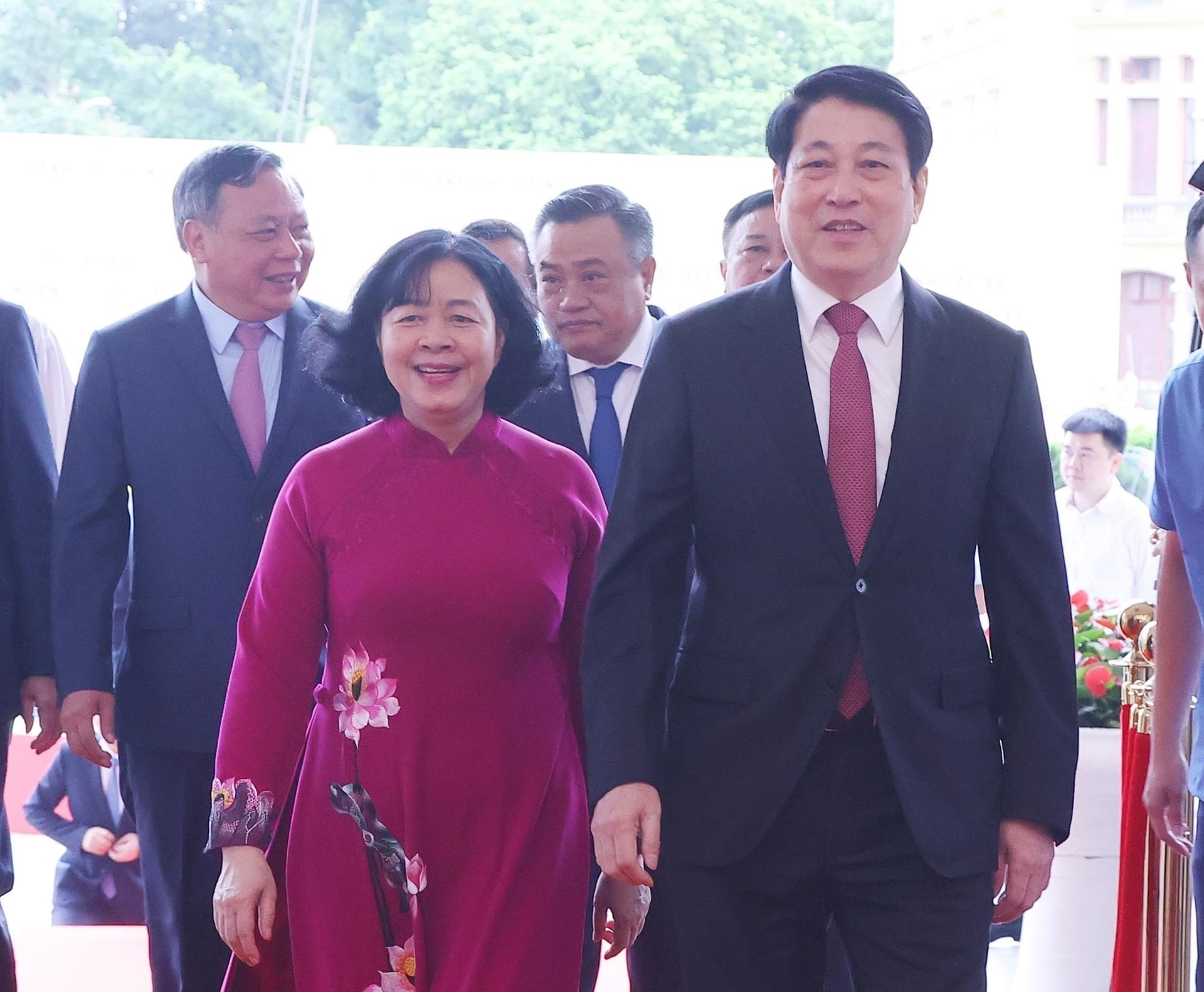
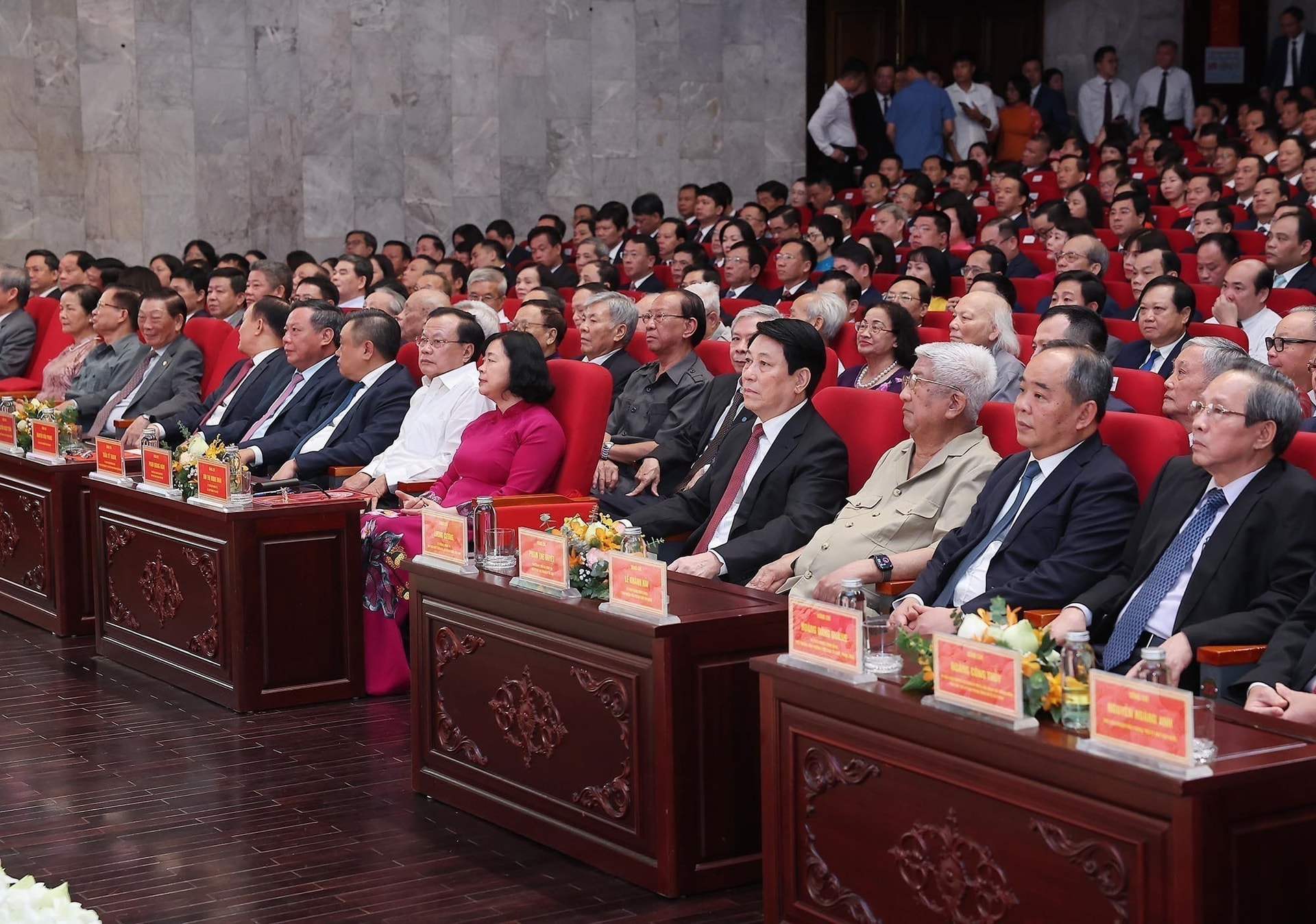
At the Hai Phong bridge, on behalf of the Party and State leaders speaking at the event, Prime Minister Pham Minh Chinh emphasized: The ceremony to announce resolutions and decisions on the organization of two-level local governments is an important, historical event, a festival of the country.
The merger of Hai Duong province and Hai Phong city has strategic significance and significance, an important historical milestone, opening a new chapter for the development of the locality and the Red River Delta region, contributing to promoting the prosperity of the country.
According to the Prime Minister, the arrangement of administrative units, the consolidation of provincial level, the disorganization of district level and the merger of commune level are major policies of the Party and State and General Secretary To Lam to perfect the organization of a streamlined State administrative apparatus, improve efficiency - effectiveness - efficiency, be closer to the people, serve the people better; streamline the payroll, improve the quality and responsibility of the team of cadres, civil servants and public employees; in line with the development trend of the times and the requirements of deep integration; at the same time, concentrate land and population resources, expand development space, and more effectively promote the distinct potential, outstanding opportunities and competitive advantages of Hai Phong and Hai Duong for development.
The Prime Minister said that Hai Phong is a historical land that witnessed glorious feats of arms against invaders, especially the three victories on the Bach Dang River; the heroic city has made great contributions to building and defending the Fatherland, in the cause of innovation, industrialization and modernization of the country; affirming its position as an important economic, industrial, commercial and service center of the country.
Hai Duong is a land that plays an important role in the history of building and defending the country, is the "eastern fence" of Thang Long Citadel; has a rich cultural history, is the birthplace of many sages and outstanding celebrities, is famous as "The Eastern Doctorate's Furnace"; today is striving to become an industrial and agricultural center.
The merger of Hai Duong province and Hai Phong city into a new administrative unit named Hai Phong city demonstrates the strategic and long-term thinking and vision of the Party and State, opening up development space, optimizing resources, resonating potentials and advantages, creating a new growth pole, promoting and contributing to leading and promoting the development of the region and the country; towards becoming a large, modern, smart, multi-functional urban area, enhancing the development of industry, logistics, seaports, trade, services, culture, education, science and technology.
The Prime Minister assessed that the serious implementation of the Resolutions and Decisions of the Party, the National Assembly, the Government, Hai Phong City and Hai Duong Province demonstrated a spirit of proactiveness, creativity, determination, professionalism, methodicalness, and science; solidarity, consensus, and prompt implementation of tasks and preparatory work, and the roadmap for unification and establishment of Party organizations, the government, the Fatherland Front, and political and social organizations at all levels; and the consolidation of the organizational apparatus, leadership, and management staff at all levels.
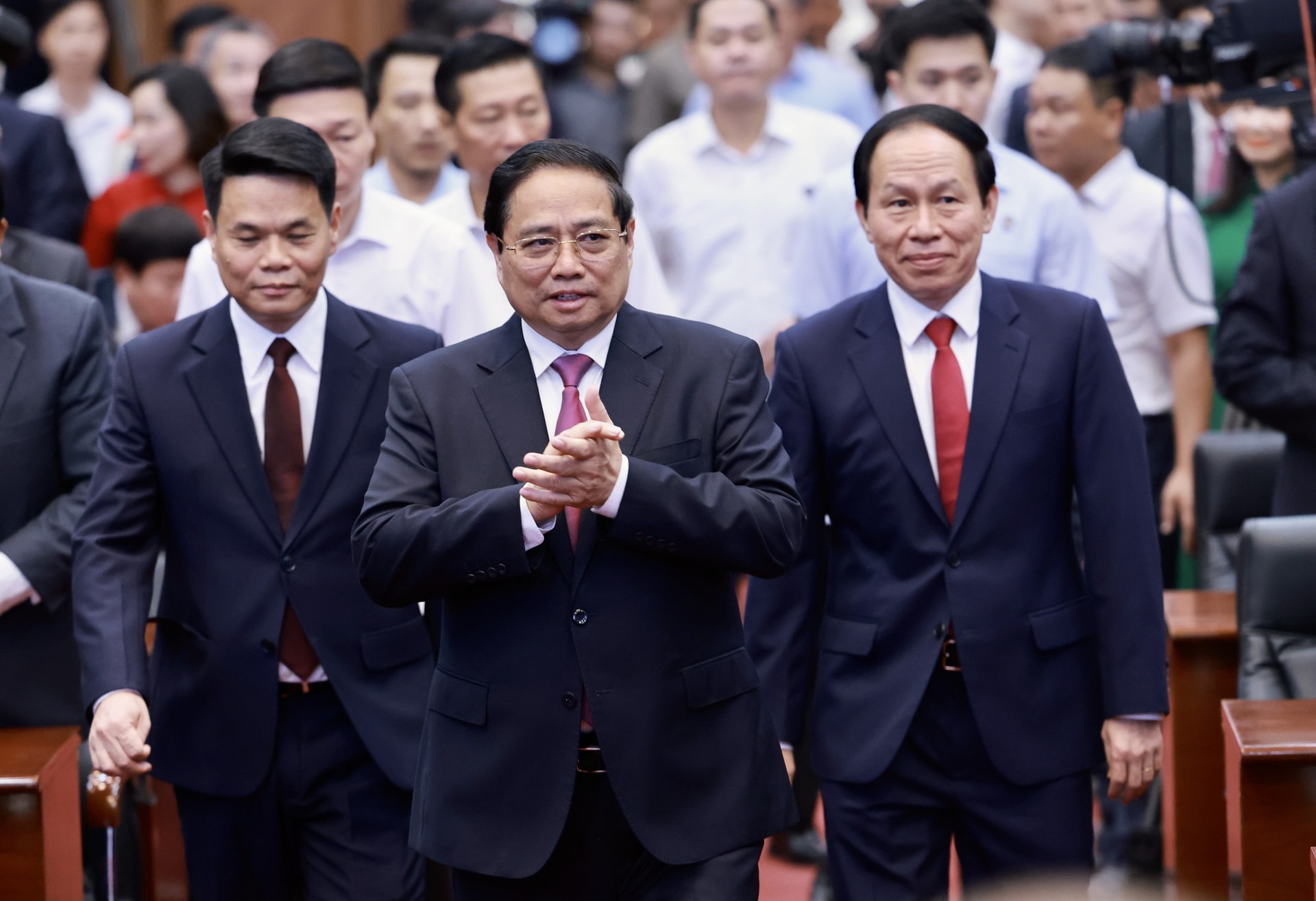
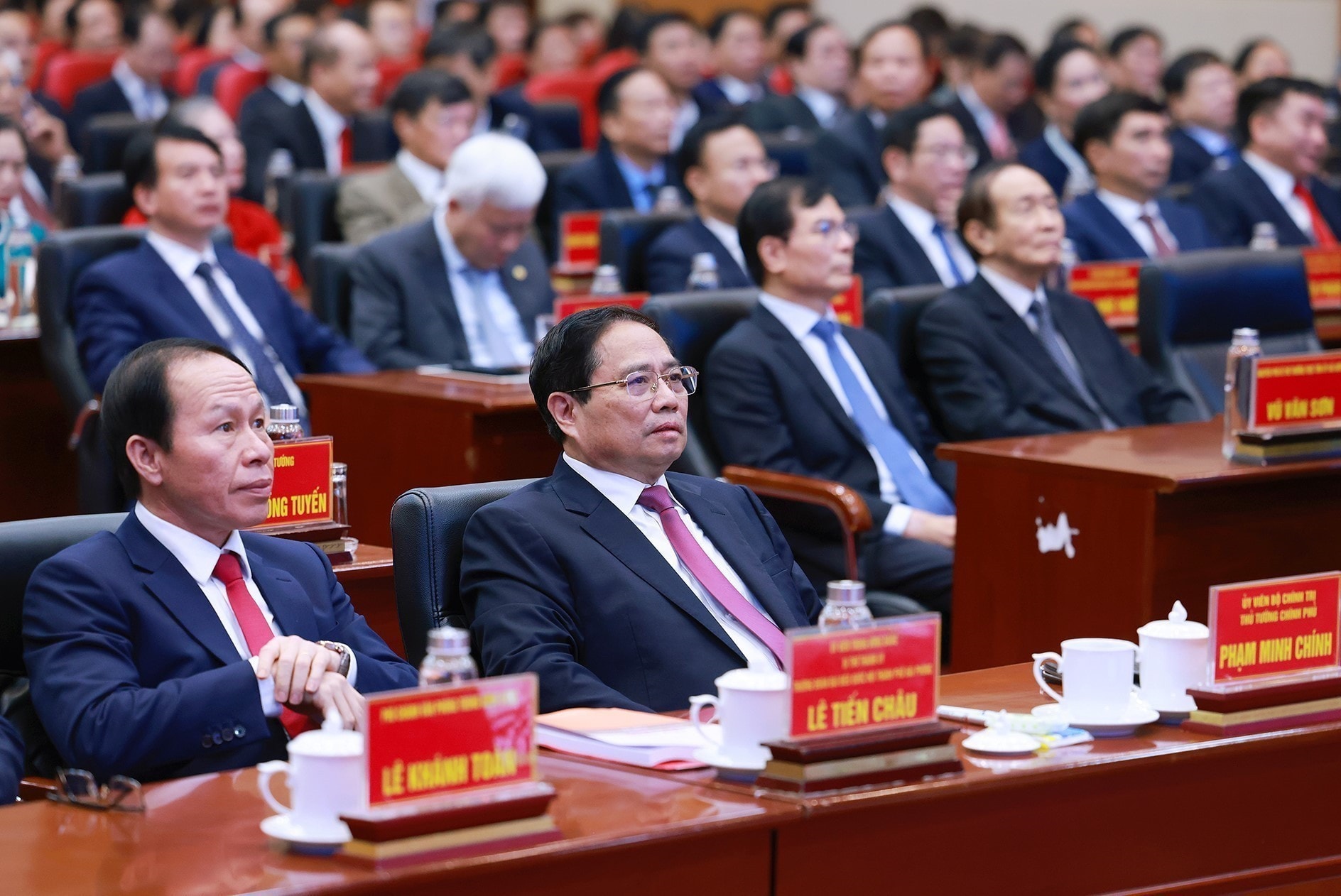
At the Can Tho bridge, National Assembly Chairman Tran Thanh Man stated: The arrangement of administrative units is a major, consistent, and continuous policy and has been focused on by the Party Central Committee, the Politburo, the Secretariat, the National Assembly, the Government and agencies in the political system to lead, direct and organize synchronous, urgent and drastic implementation nationwide with the goal of officially putting into operation a 2-level local government from July 1, 2025; ensuring the reduction of the intermediate class, being close to the people, the government acting quickly, flexibly, centrally, responsibly, promoting decentralization, decentralization, creating a new development space, the apparatus of the political system is streamlined, compact, strong, efficient, effective and efficient.
The arrangement of administrative units is a difficult, sensitive, and complicated task, greatly affecting the organization and operation of agencies and organizations in the political system, of the contingent of cadres, civil servants, public employees, workers, and the ideology, psychology, cultural differences, and long-standing customs and practices of the people of each locality. In that context, the National Assembly Chairman highly appreciated the City Party Committee, Provincial Party Committee, People's Council, People's Committee, Fatherland Front Committee, and National Assembly delegations of the three localities of Can Tho, Hau Giang, and Soc Trang for focusing on leadership, direction, coordination, and mobilization of the entire political system with a spirit of urgency, seriousness, determination, and high responsibility, conducting it methodically, scientifically, and firmly according to the order, procedures, and instructions of the Central Government and ensuring quality and progress; at the same time, creating unity among cadres, party members, and high consensus and support from all walks of life.
At this historic moment, the National Assembly Chairman expressed his respect, honor and deep gratitude for the great and persistent contributions of Party committees at all levels, authorities, the Fatherland Front, and local organizations, especially at the district and commune levels, before implementing the administrative unit arrangement; acknowledged and commended the contributions of generations of cadres, civil servants, public employees, soldiers of the armed forces, and people of Can Tho city, Hau Giang province and Soc Trang province who have made important contributions to the development of this land rich in revolutionary traditions.
The National Assembly Chairman emphasized that this historic decision not only marks a turning point in administrative organization but also recalls the three localities that were once closely linked under the common roof of Hau Giang province. And today, Can Tho city, Soc Trang province, Hau Giang province, merged to take the name Can Tho city to have the opportunity to implement the valuable lesson that our ancestors have learned for generations: one tree cannot make a forest, three trees together can make a high mountain. This is a favorable premise to carry out economic, cultural and social development linkages, ensure national defense and security; expand development space, clearly position the role of the regional economic center, with enough scope to lead the entire Mekong Delta region in accordance with the spirit of Resolution No. 59-NQ/TW of the Politburo on building and developing Can Tho city to 2030, with a vision to 2045; Resolution No. 45/2022/QH15 of the National Assembly on piloting a number of specific mechanisms and policies for the development of Can Tho city and applied immediately to the new Can Tho city.
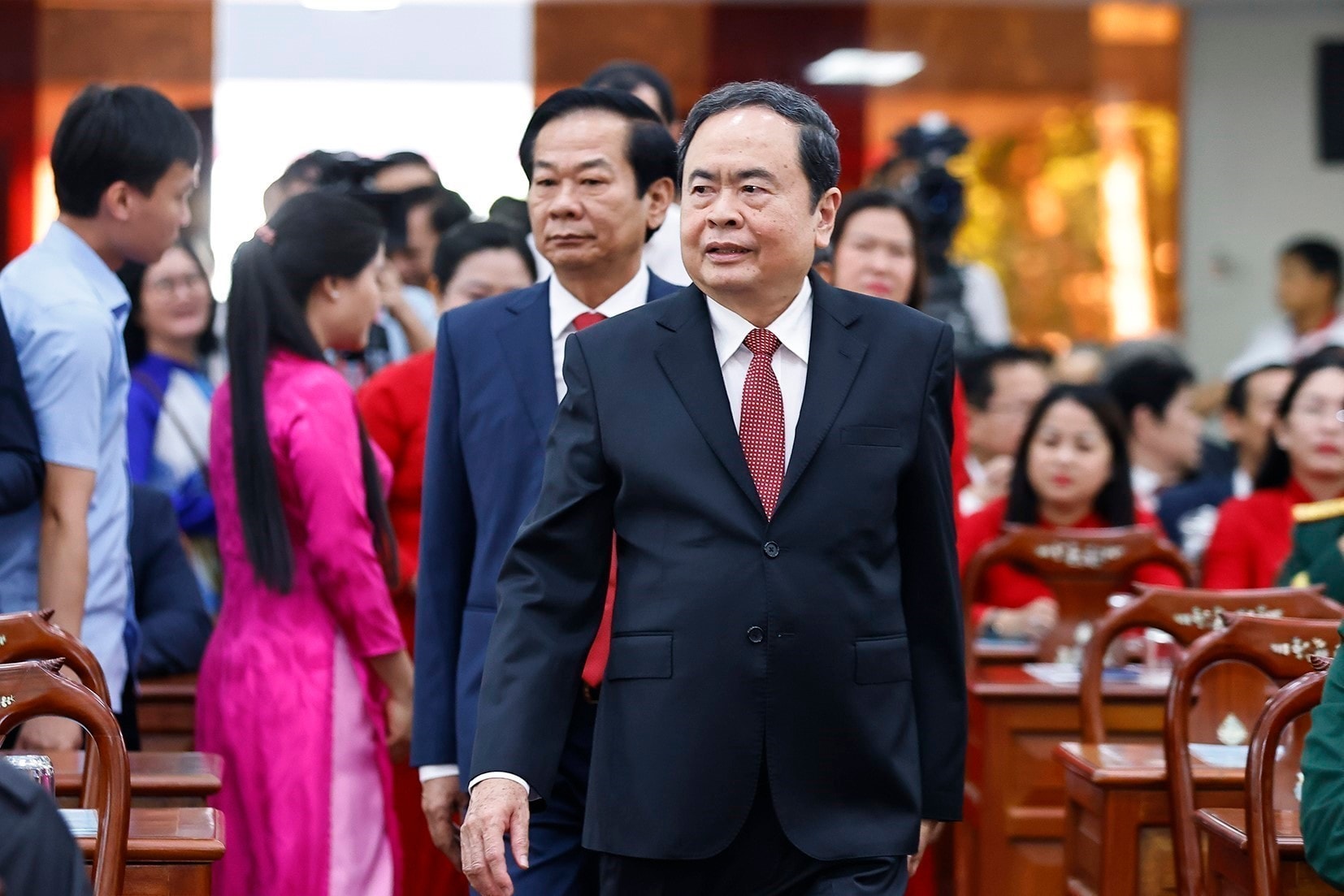
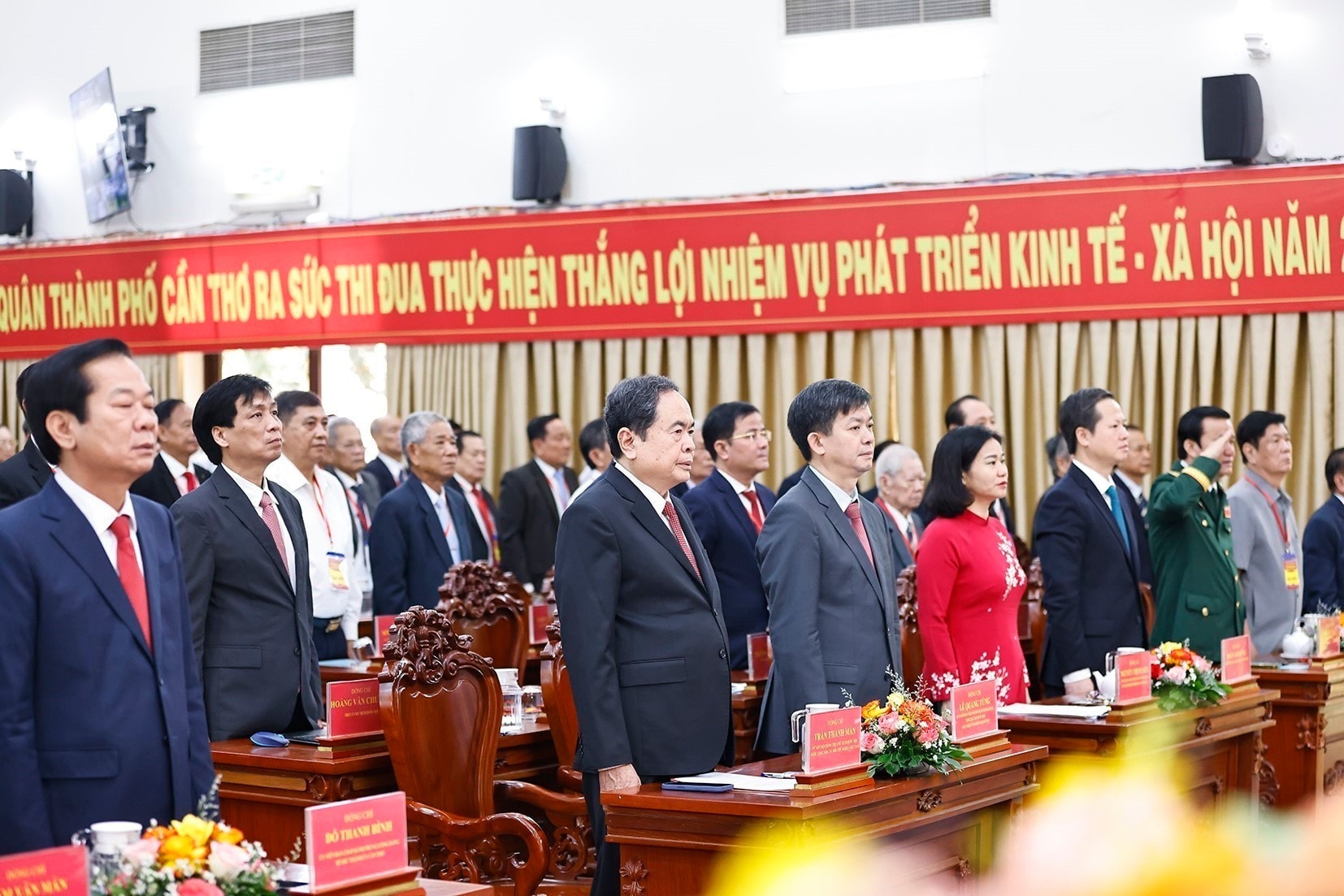
The Politburo and the Secretariat appoint provincial and municipal party secretaries.
Pursuant to the provisions of Section I of Instruction No. 31-HD/BTCTW dated April 23, 2025 of the Central Organizing Committee on the establishment of party organizations corresponding to local administrative units and the arrangement of the apparatus of the Vietnam Fatherland Front and provincial and communal-level mass organizations: Regarding the establishment of the Party Committees of provinces and centrally run cities (new) after the merger of provincial-level administrative units, the Central Organizing Committee shall appraise the projects of the provincial and municipal Party Committees; advise and submit to the Politburo and the Secretariat to decide on the establishment of Party Committees of provinces and centrally run cities, appoint the executive committee, standing committee, secretary, deputy secretary of the provincial and municipal Party Committees, inspection committee, chairman and deputy chairman of the inspection committee of the provincial and municipal Party Committees for the 2020-2025 term, with the completion time synchronous with the merger of provincial-level administrative units (no later than September 15, 2025).
List of 23 new provincial and municipal Party Secretaries after the merger:
- Comrade Nguyen Van Gau, Member of the Party Central Committee, Secretary of Bac Ninh Provincial Party Committee.
- Comrade Trinh Xuan Truong, Secretary of Lao Cai Provincial Party Committee.
- Comrade Truong Quoc Huy, Secretary of Ninh Binh Provincial Party Committee.
- Comrade Nguyen Van Quyet, Secretary of Tay Ninh Provincial Party Committee.
- Comrade Nguyen Ho Hai, Secretary of Ca Mau Provincial Party Committee.
- Comrade Nguyen Dinh Trung, Member of the Party Central Committee, Secretary of Dak Lak Provincial Party Committee.
- Comrade Vu Hong Van, Secretary of Dong Nai Provincial Party Committee.
- Comrade Trinh Viet Hung, Alternate Member of the Party Central Committee, Secretary of Thai Nguyen Provincial Party Committee.
- Comrade Bui Thi Quynh Van, Member of the Party Central Committee, Secretary of Quang Ngai Provincial Party Committee.
- Comrade Nghiem Xuan Thanh, Member of the Party Central Committee, Secretary of Khanh Hoa Provincial Party Committee.
- Comrade Nguyen Van Quang, Member of the Party Central Committee, Secretary of the Da Nang City Party Committee.
- Comrade Le Ngoc Quang, Member of the Party Central Committee, Secretary of Quang Tri Provincial Party Committee.
- Comrade Le Quoc Phong, Member of the Party Central Committee, Secretary of Dong Thap Provincial Party Committee.
- Comrade Dang Xuan Phong, Member of the Party Central Committee, Secretary of Phu Tho Provincial Party Committee.
- Comrade Nguyen Huu Nghia, Member of the Party Central Committee, Secretary of Hung Yen Provincial Party Committee.
- Comrade Hau A Lenh, Member of the Party Central Committee, Secretary of Tuyen Quang Provincial Party Committee.
- Comrade Y Thanh Ha Nie K' Dam, Member of the Party Central Committee, Secretary of Lam Dong Provincial Party Committee.
- Comrade Nguyen Tien Hai, Member of the Party Central Committee, Secretary of An Giang Provincial Party Committee.
- Comrade Ngo Chi Cuong, Member of the Party Central Committee, Secretary of Vinh Long Provincial Party Committee.
- Comrade Do Thanh Binh, Member of the Party Central Committee, Secretary of Can Tho City Party Committee.
- Comrade Ho Quoc Dung, Member of the Party Central Committee, Secretary of Gia Lai Provincial Party Committee.
- Comrade Nguyen Van Nen, Politburo member, Secretary of Ho Chi Minh City Party Committee.
- Comrade Le Tien Chau, Member of the Party Central Committee, Secretary of Hai Phong City Party Committee.
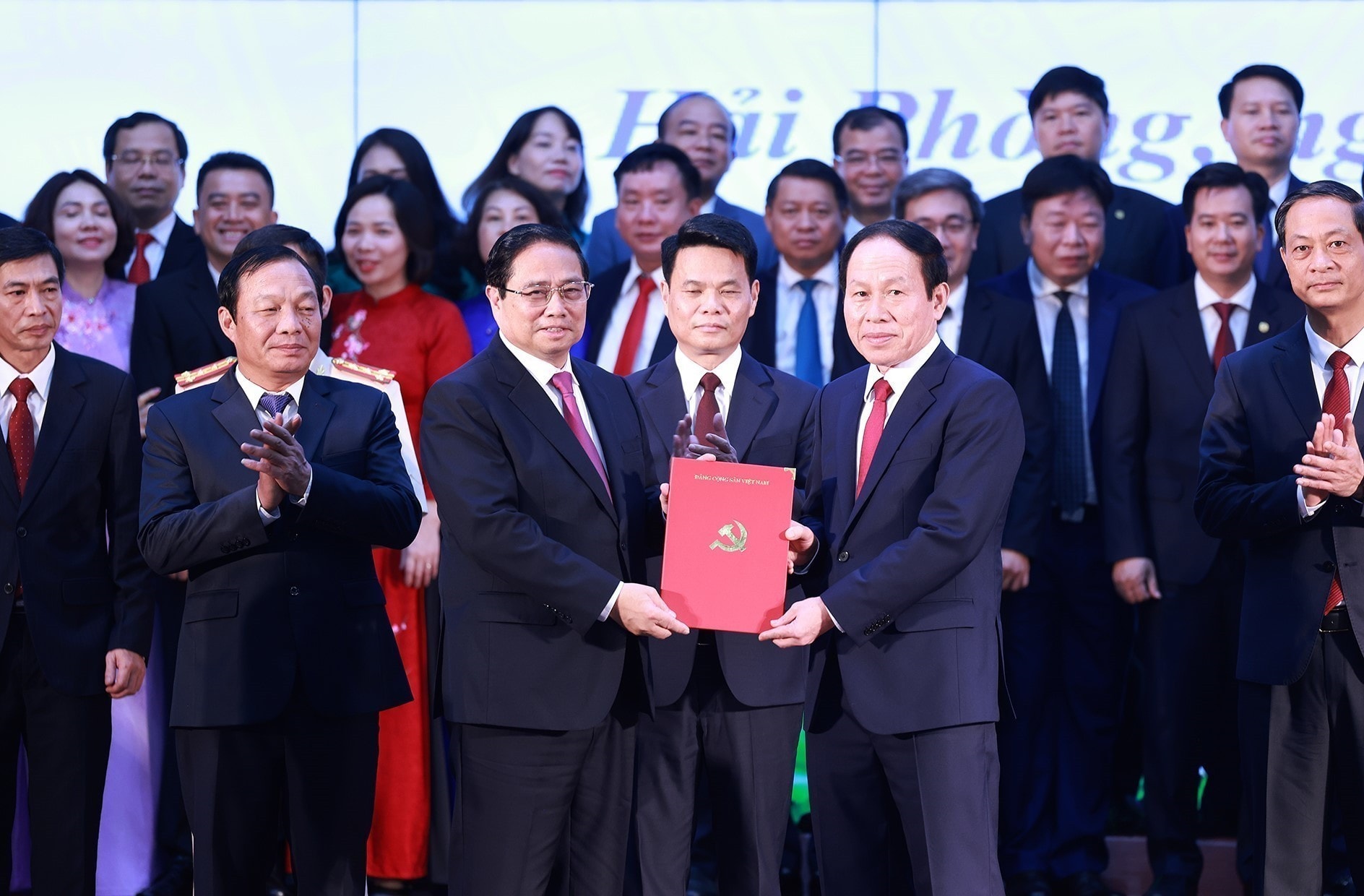
* The Standing Committee of the National Assembly appoints the Chairman of the People's Council of the province or city
On June 12, 2025, National Assembly Chairman Tran Thanh Man signed and issued Resolution No. 202/2025/QH15 of the National Assembly on the arrangement of provincial-level administrative units. Accordingly, our country officially has 34 provinces and cities, including 28 provinces and 6 centrally-run cities. The Resolution also resolved that competent agencies urgently carry out necessary preparations to ensure that local governments in provinces and cities formed after the arrangement stipulated in Article 1 of this Resolution officially operate from July 1, 2025.
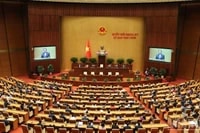
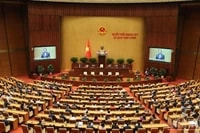
23 Resolution on the National Assembly Delegation and the appointment of the Head and Deputy Head of the National Assembly Delegation, 15th tenure
Local governments in provinces and cities previously arranged shall continue to operate until local governments in provinces and cities formed after the arrangement officially operate.
Pursuant to the provisions of Clause 3, Article 2 of Resolution No. 203/2025/QH15 of the National Assembly on Amending and Supplementing a Number of Articles of the Constitution of the Socialist Republic of Vietnam (Resolution passed by the National Assembly on June 16, 2025), it is stipulated as follows: When perfecting the organizational apparatus of agencies after implementing the arrangement of administrative units and ending the operation of district-level administrative units in 2025, the positions of Chairman, Vice Chairman of the People's Council, Head of Committees of the People's Council, Chairman, Vice Chairman, and Member of the People's Committee shall not be elected in the administrative units formed after the arrangement; the Head and Deputy Head of the National Assembly Delegation of provinces and centrally run cities formed after the arrangement shall not be elected. Based on the announcement of the Party Committee with authority to manage cadres, the Standing Committee of the National Assembly appoints the Chairman, Vice Chairman of the People's Council, Heads of the People's Council Committees, Heads and Deputy Heads of the National Assembly Delegation in the provinces and centrally-run cities formed after the reorganization.
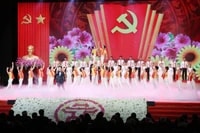
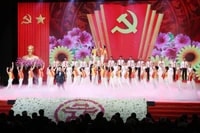
Resolution appointing Chairman and Vice Chairman of People's Councils of provinces and cities
The Prime Minister appoints the Chairman and Vice Chairman of the People's Committee in the provinces and centrally-run cities formed after the reorganization.
The Standing Committee of the People's Council of a province or centrally run city shall appoint members of the People's Committee of the same level and appoint the Chairman, Vice Chairman of the People's Council, Heads of the People's Council Committees, Chairman, Vice Chairman of the People's Committee of the lower-level administrative unit formed after the rearrangement; The Standing Committee of the People's Council of the lower-level administrative unit formed after the rearrangement shall appoint members of the People's Committee of the same level.
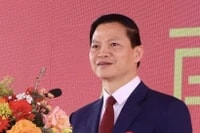
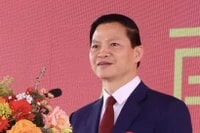
List of Chairmen of People's Committees of new provinces and cities after merger
In special cases, it is allowed to appoint personnel who are not People's Council delegates to hold the positions of Chairman, Vice Chairman, Head of Committees of the People's Council in administrative units formed after the arrangement or to act as People's Council delegates to form provisional People's Councils in wards implementing the urban government model without organizing People's Councils.
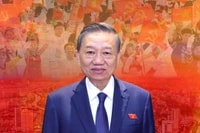
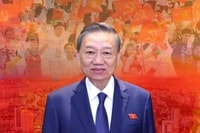
The power of unity
Source: https://baolamdong.vn/le-cong-bo-nghi-quyet-cua-quoc-hoi-ve-sap-nhap-tinh-thanh-pho-273260.html


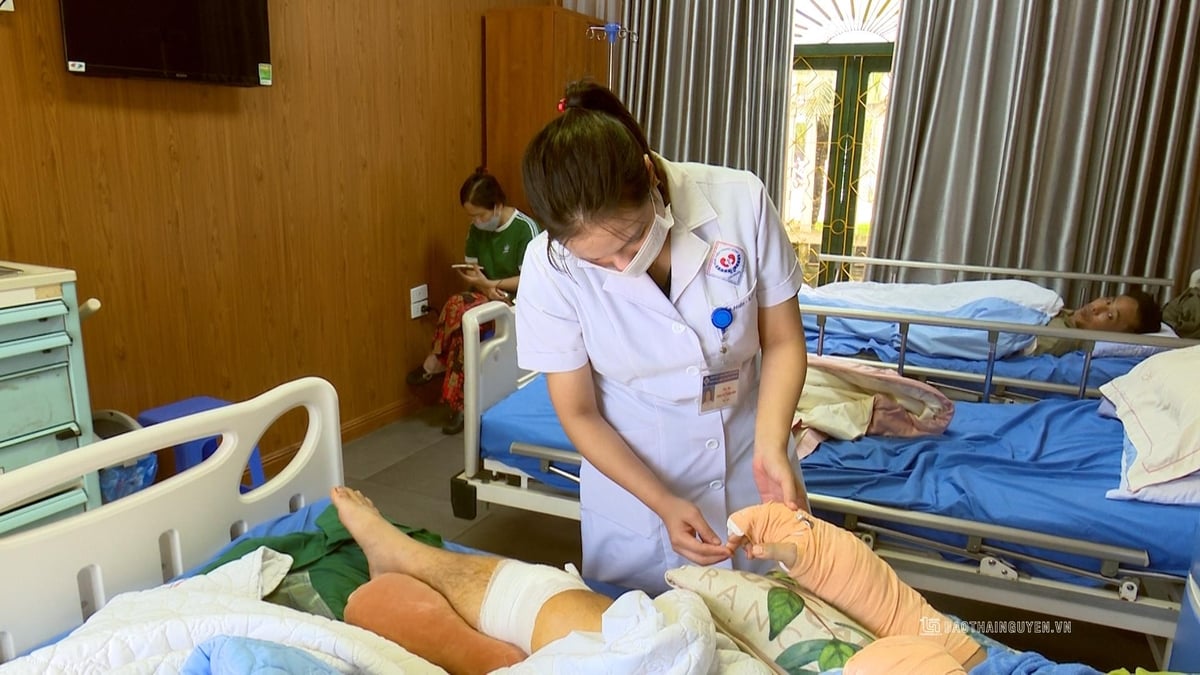
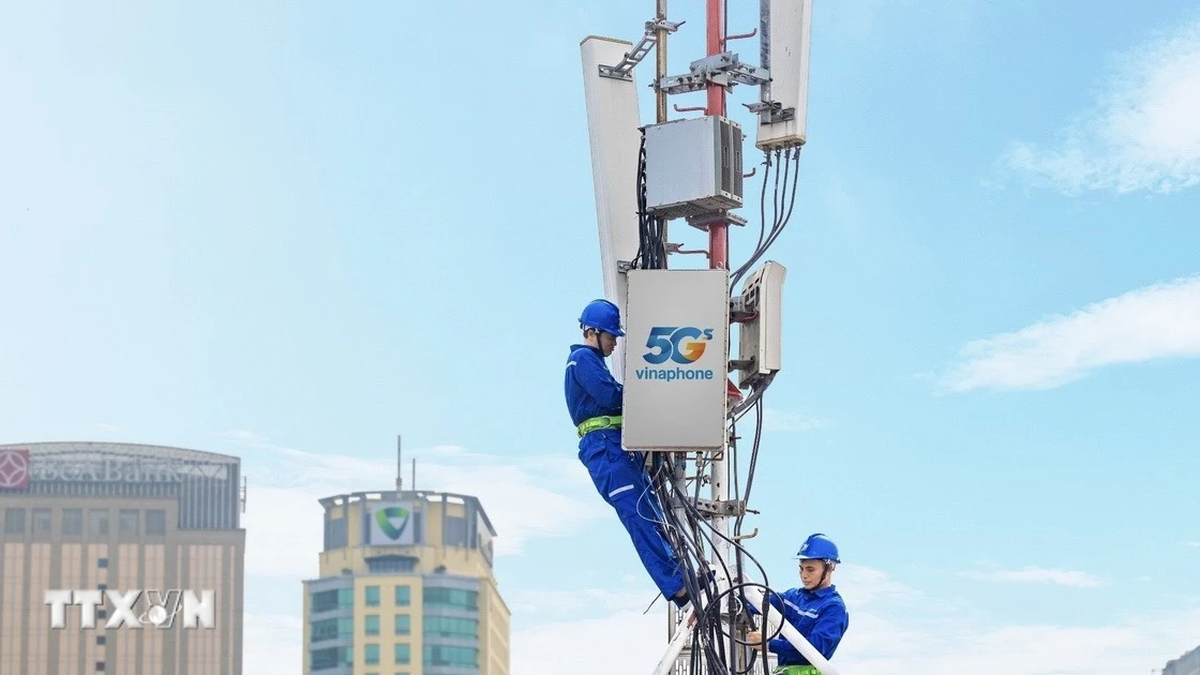

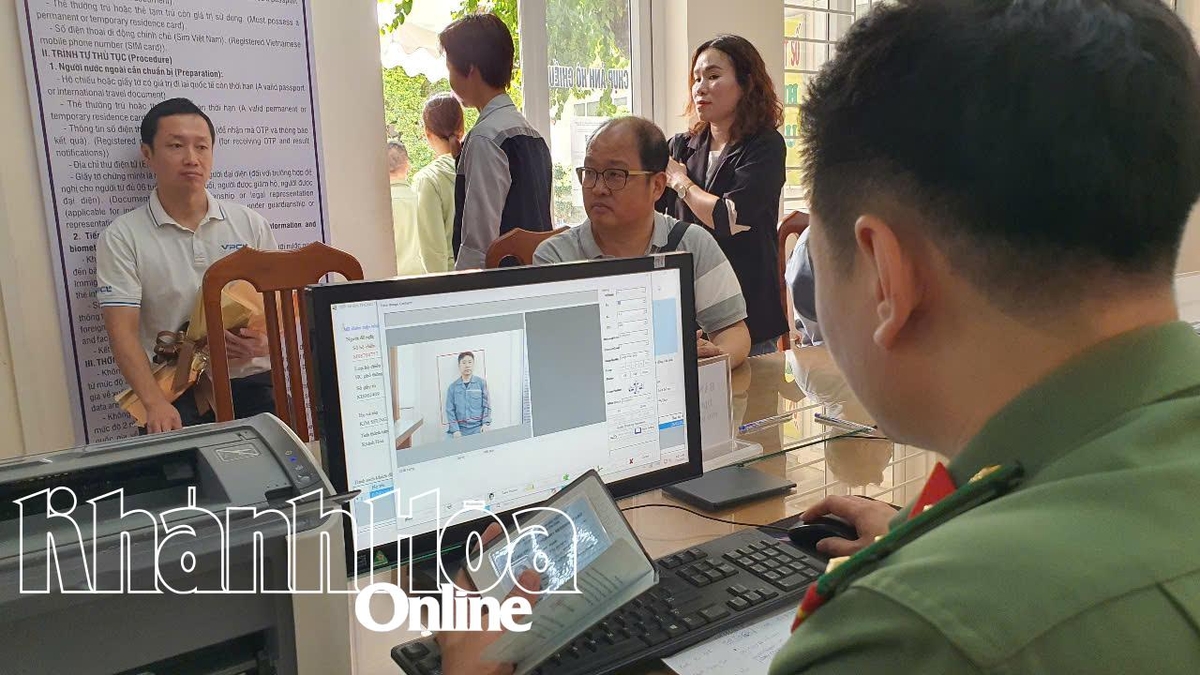



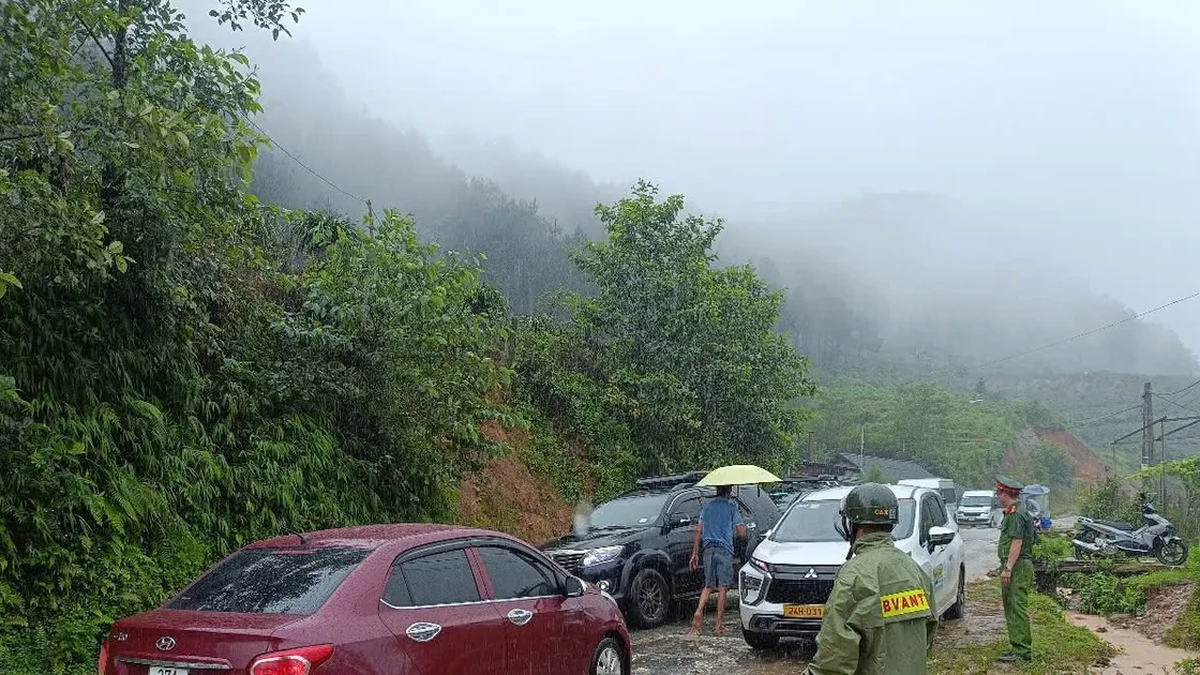
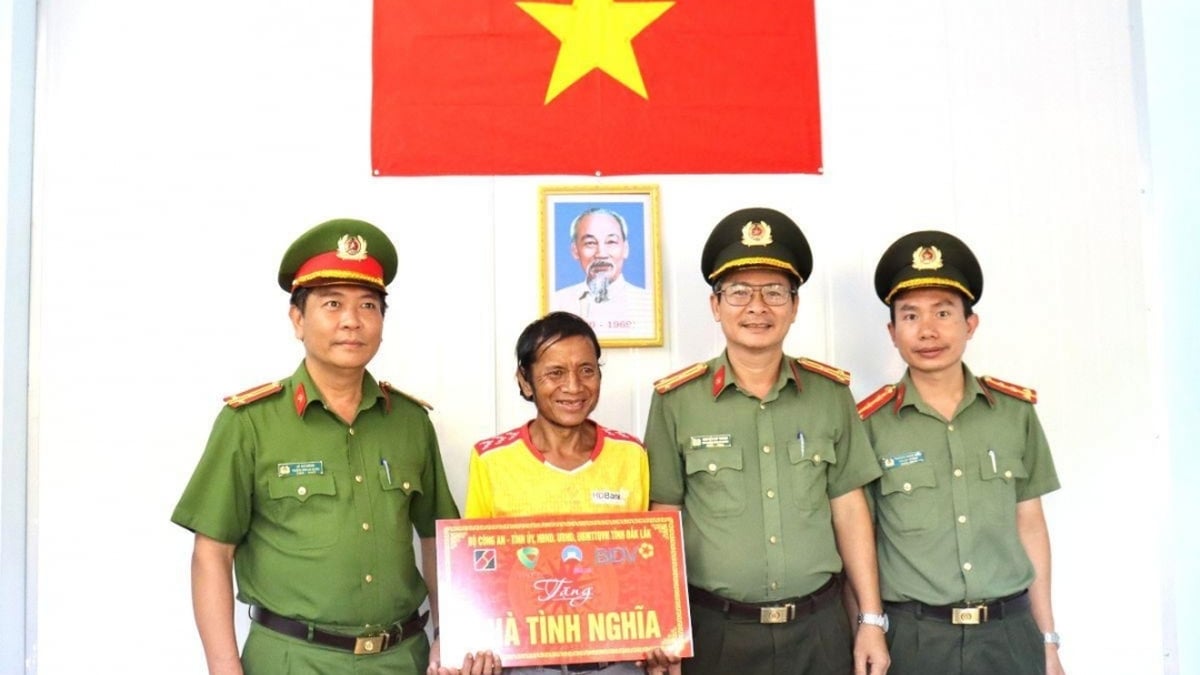






















































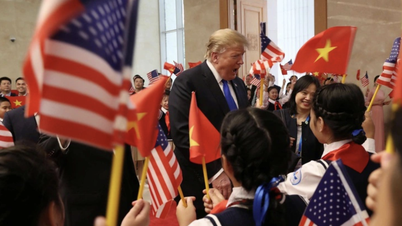
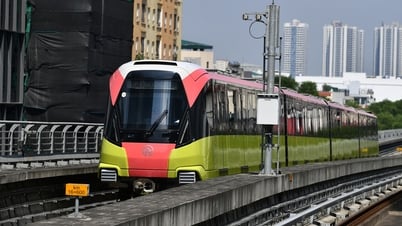
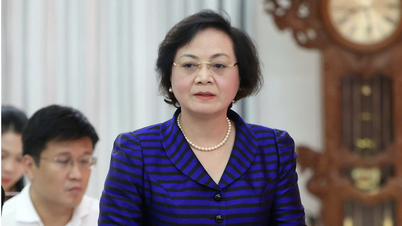

































Comment (0)